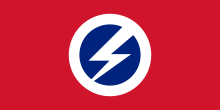Flash and circle
This article needs additional citations for verification. (February 2017) |

The flash and circle is a political symbol used by several organisations. It was first used by the British Union of Fascists (BUF), and was adopted in 1935. The BUF had originally used the fasces as its symbol, first on a black disc on a gold background and later in gold with a lightning bolt struck through it on a black background. The flash and circle was designed as a more abstract depiction of the concept of the fasces incorporating the lightning of the 1933 flag within a "circle of unity" and the British national colours of red, white and blue. Oswald Mosley's post-war group the Union Movement and his National Party of Europe initiative continued to use the flash.
The American National Renaissance Party adopted the lightning bolt within a circle as their symbol, which superseded Madole's use of the swastika. It decorated their rostrum and was worn on their armbands.
The BUF's left-wing opponents nicknamed the symbol "the flash in the pan".[1]

The insignia of Singapore's People's Action Party (PAP) is composed of a red flash struck through a smaller blue circle on a white background. The PAP insignia is claimed to represent "action within social/racial unity" with the white background representing purity in thought and deed.[2]
A similar logo was adopted by Blocco Studentesco, the youth wing of Italy's CasaPound movement in 2006. The group has been accused of fascist propaganda.
Similar non-political symbols
The simple combination of the lightning bolt and circle elements appears to have led to many similar designs unrelated to the flash and circle. These include the logo of BoltBus. One form of warning sign for high-voltage electricity uses a lightning bolt inside a circle, and this was repurposed by Marilyn Manson as an insignia for his album Antichrist Superstar.[3] In most cases, there is no evidence to suggest that the designer intended to evoke an association with political use of the symbol.
In popular culture
Parodies and fictional representations of fascist movements have also incorporated logos similar to the flash and circle.

In the alternate history film It Happened Here, the flash and circle is used as the symbol of the fascist puppet government in Nazi-occupied Britain.
In one television adaptation of the Jeeves novels by P. G. Wodehouse, Jeeves and Wooster, a similar insignia is used by the "Blackshorts", a political group led by Roderick Spode, a character based on Sir Oswald Mosley, the founder of the British Union of Fascists.
References
- ^ Benewick, Robert (1969), Political Violence & Public Order: A Study of British Fascism, p. 139
- ^ Drysdale, John (1984), Singapore: Struggle for Success, p. 80
- ^ Baddeley, Gavin (2001). Dissecting Marilyn Manson. London: Plexus Publishing. pp. 101–102. ISBN 0859653722 – via GoogleBooks.
The insignia that represents the Antichrist Superstar album ... also echoes the insignia of Oswald Moseley's British Union of Fascists...


